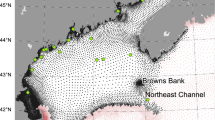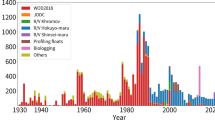Abstract
The in situ sea surface salinity (SSS) measurements from a scientific cruise to the western zone of the southeast Indian Ocean covering 30°–60°S, 80°–120°E are used to assess the SSS retrieved from Aquarius (Aquarius SSS). Wind speed and sea surface temperature (SST) affect the SSS estimates based on passive microwave radiation within the mid- to low-latitude southeast Indian Ocean. The relationships among the in situ, Aquarius SSS and wind-SST corrections are used to adjust the Aquarius SSS. The adjusted Aquarius SSS are compared with the SSS data from MyOcean model. Results show that: (1) Before adjustment: compared with MyOcean SSS, the Aquarius SSS in most of the sea areas is higher; but lower in the low-temperature sea areas located at the south of 55°S and west of 98°E. The Aquarius SSS is generally higher by 0.42 on average for the southeast Indian Ocean. (2) After adjustment: the adjustment greatly counteracts the impact of high wind speeds and improves the overall accuracy of the retrieved salinity (the mean absolute error of the Zonal mean is improved by 0.06, and the mean error is - 0.05 compared with MyOcean SSS). Near the latitude 42°S, the adjusted SSS is well consistent with the MyOcean and the difference is approximately 0.004.
Similar content being viewed by others
References
Bahurel P, Adragna F, Bell M J, et al. 2010. Ocean Monitoring and Forecasting Core Services: The European MyOcean Example. In: Hall J, Harrison D E, Stammer, D, Eds. Proceedings of OCEANOBS’09 Sustained Ocean Observations and Information for Society. Venice, Italy: ESA Publication WPP-306, 2–11
Banks C J, Gommenginger C P, Srokosz M A, et al. 2012. Validating SMOS ocean surface salinity in the Atlantic with Argo and operational ocean model data. IEEE Transactions on Geoscience and Remote Sensing, 50(5): 1688–1702
Boutin J, Martin N, Yin Xiaobin, et al. 2012. First assessment of SMOS data over open ocean: Part II Sea surface salinity. IEEE Transactions on Geoscience and Remote Sensing, 50(5): 1662–1675
Camps A, Font J, Vall-llossera M, et al. 2004. The WISE 2000 and 2001 field experiments in support of the SMOS Mission: Sea surface L-Band brightness temperature observations and their application to sea surface salinity retrieval. IEEE Transactions on Geoscience and Remote Sensing, 42(4): 804–823
Chen Jian, Zhang Ren, Wang Huizan, et al. 2014. An analysis on the error structure and mechanism of soil moisture and ocean salinity remotely sensed sea surface salinity products. Acta Oceanologica Sinica, 33(1): 48–55
Cheng Y, Andersen O B, Knudsen P. 2012. First evaluation of MyOcean altimetric data in the Arctic Ocean. Ocean Science Discussions, 9(1): 291–314
Ebuchi N, Abe H. 2012. Evaluation of sea surface salinity observed by Aquarius. In: 2012IEEE International Geoscience and Remote Sensing Symposium (IGARSS). Munich: IEEE, 5767–5769
Feng Shizuo, Li Fengqi, Li Shaoqing. 1999. An Introduction to Marine Science (in Chinese). Beijing: The Higher Education Press, 83–108
Font J, Lagerloef G, Le Vine D, et al. 2003. The determination of surface salinity with SMOS-recent results and main issues. In: Proceedings of 2003 IEEE International Geoscience and Remote Sensing Symposium (IGARSS'03). Toulouse, France: IEEE, 7–9
Glejin J, Kumar V S, Nair T M B. 2013. Monsoon and cyclone induced wave climate over the near shore waters off Puduchery, south western Bay of Bengal. Ocean Engineering, 72: 277–286
Guinehut S, Dhomps A L, Larnicol G, et al. 2012. High resolution 3-D temperature and salinity fields derived from in situ and satellite observations. Ocean Science, 8(5): 845–857
Kerr Y H, Waldteufel P, Wigneron J P, et al. 2001. Soil moisture retrieval from space: The Soil Moisture and Ocean Salinity (SMOS) mission. IEEE Transactions on Geoscience and Remote Sensing, 39(8): 1729–1735
Kerr Y H, Waldteufel P, Wigneron J P, et al. 2010. The SMOS Mission: New tool for monitoring key elements of the global water cycle. Proceedings of the IEEE, 98(5): 666–68
Lagerloef G. 2012. Satellite mission monitors ocean surface salinity. Eos, Transacations American Geophysical Union, 93(25): 233–234
Lagerloef G, Colomb F R, Le Vine D, et al. 2008. The Aquarius/SAC-D Mission: Designed to meet the salinity remote-sensing challenge. Oceanography, 21(1): 68–81
Lerner R M, Hollinger J P. 1977. Analysis of 1.4 GHz radiometric measurements from Skylab. Remote Sensing of Environment, 6(4): 251–269
Le Vine D M, Lagerloef G S E, Colomb F R, et al. 2007. Aquarius: An instrument to monitor sea surface salinity from space. IEEE Transactions on Geoscience and Remote Sensing, 45(7): 2040–2050
Le Vine D M, Lagerloef G S E, Torrusio S E. 2010. Aquarius and remote sensing of sea surface salinity from space. Proceedings of the IEEE, 98(5): 688–703
Le Vine D M. 2011. Aquarius Instrument and Salinity Retrieval. h t t p: / / a q u a r i u s. u m a i n e. e d u / c g i / d o c u m e n t s. h t m [03–Jun–2011]
Liang Yuqing, Liu Jinfang, Zhang Xian, et al. 2003. Temporal and spatial characteristics of South Indian Ocean wind field. Marine Forecasts (in Chinese), 20(1): 25–31
Lu Zhaoshi, Shi Jiuxin, Jiao Yutian, et al. 2006. Experimental study of microwave remote sensing of sea surface salinity. Ocean Technology (in Chinese), 25(3): 70–75, 89
Luis A J, Pandey P C. 2005. Characteristics of atmospheric divergence and convergence in the Indian Ocean inferred from scatterometer winds. Remote Sensing of Environment, 97(2): 231–237
Meissner T, Wentz F, Lagerloef G, et al. 2012. The Aquarius salinity retrieval algorithm. In: 2012 12th Specialist Meeting on Microwave Radiometry and Remote Sensing of the Environment. Rome: IEEE, 1–3
Nardelli B B, Tronconi C, Pisano A, et al. 2013. High and Ultra-High resolution processing of satellite Sea Surface Temperature data over Southern European Seas in the framework of MyOcean project. Remote Sensing of Environment, 129: 1–16
Ratheesh S, Sharma R, Sikhakolli R, et al. 2014. Assessing sea surface salinity derived by Aquarius in the Indian Ocean. IEEE Geoscience and Remote Sensing Letters, 11(4): 719–722
Reagan J, Boyer T, Antonov J. 2013. Comparison analysis between Aquarius sea surface salinity and world ocean database in situ analyzed sea surface salinity.http://aquarius.umeoce.maine.edu/docs/aqsci2013_reagan.pdf [2013–11]
Reagan J, Boyer T, Antonov J. 2014. Comparison analysis between Aquarius sea surface salinity and World Ocean Database in situ analyzed sea surface salinity. Journal of Geophysical Research: Oceans, 119(11): 8122–8140
Reynolds R W, Rayner N A, Smith T M, et al. 2002. An improved in situ and satellite SST analysis for climate. Journal of Climate, 15(13): 1609–1625
Sabia R, Camps A, Talone M, et al. 2010. Determination of the sea surface salinity error budget in the Soil Moisture and Ocean Salinity Mission. IEEE Transactions on Geoscience and Remote Sensing, 48(4): 1684–1693
mitt R W. 2008. Salinity and the global water cycle. Oceanography, 21(1): 12–19
Sharma R, Agarwal N, Momin I M, et al. 2010. Simulated sea surface salinity variability in the Tropical Indian Ocean. Journal of Climate, 23(24): 6542–6554
Shi Jiuxin, Lu Zhaoshi, Li Shujiang, et al. 2006. Retrieval algorithm for seawater's salinity and temperature by L and S band microwave remote sensing. Chinese High Technology Letters (in Chinese), 16(11): 1181–1184
Wang Xinxin, Yang Jianhong, Zhao Dongzhi, et al. 2013. SMOS satellite salinity data accuracy assessment in the China coastal areas. Haiyang Xuebao (in Chinese), 35(5): 169–176
Wentz F J, Le Vine D. 2008. Algorithm theoretical basis document Aquarius level-2 radiometer algorithm: Revision 1. RSS Technical Report 012208, http://oceancolor.gsfc.nasa.gov/AQUARIUS/DOCS/Level2_salinity_atbd_rev1.pdf
Xie Shangping, Annamalai H, Schott F A, et al. 2002. Structure and mechanisms of South Indian Ocean climate variability. Journal of Climate, 15(8): 864–878
Yin Xiaobin, Liu Yuguang, Zhang Hande, et al. 2005. Microwave remote sensing of sea surface salinity—A study on microwave radiation theory of calm sea surface. Chinese High Technology Letters (in Chinese), 15(8): 86–90
Yin Xiaobin, Liu Yuguang, Zhang Hande. 2006. Removing the impact of wind direction on remote sensing of sea surface salinity. Chinese Science Bulletin, 51(11): 1368–1373
Yin Xiaobin, Liu Yuguang, Zhang Hande. 2006. Removing the impact of wind direction on remote sensing of sea surface salinity. Chinese Science Bulletin (in Chinese), 51(3): 349–354
Yueh S H, West R, Wilson W J, et al. 2001. Error sources and feasibility for microwave remote sensing of ocean surface salinity. IEEE Transactions on Geoscience and Remote Sensing, 39(5): 1049–1060
Zhao Kai, Shi Jiuxin, Zhang Hande. 2008. High sensitivity airborne Lband microwave radiometer measurements of sea surface salinity. Journal of Remote Sensing (in Chinese), 12(2): 277–283
Author information
Authors and Affiliations
Corresponding author
Additional information
Foundation item: The National Natural Science Foundation of China under contract No. 41371391; the Innovative Youth Foundation of Ocean Telemetry Engineering and Technology Centre of State Oceanic Administration under contract No. 201302; the Program for the Specialized Research Fund for the Doctoral Program of Higher Education of China under contract No. 20120091110017.
Rights and permissions
About this article
Cite this article
Xia, S., Ke, C., Zhou, X. et al. Assessment and adjustment of sea surface salinity products from Aquarius in the southeast Indian Ocean based on in situ measurement and MyOcean modeled data. Acta Oceanol. Sin. 35, 54–62 (2016). https://doi.org/10.1007/s13131-016-0818-9
Received:
Accepted:
Published:
Issue Date:
DOI: https://doi.org/10.1007/s13131-016-0818-9




